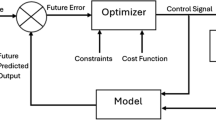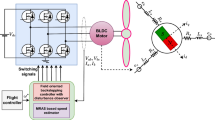Abstract
The rotor’s stable suspension is one of significant requirements for a magnetically suspended control momentum gyroscope (MSCMG), the gyroscopic effect is one of rotor’s prominent characteristics. To find out the relationship between rotor’s structure and gyroscopic effect, the inertia-ratio is originally presented and the relationship between the inertia-ratio and gyroscopic effects is researched. To improve the rotor’s suspension stability, the cross feedback control (CFC) method is researched based on modeling the suspension system of rotor and point out that only distributed PID control cannot make rotor’s suspension be stable due to the whirling. To suppress the gyroscopic effects more effectively and sustain the stable suspension within a wider speed range, a CFC method with pre-modulated gains is presented. All research results verify that this presented CFC method can effectively suppress the rotor’s vibration caused by its gyroscopic effects. Experimental results also indicate that a large inertia-ratio is helpful to suppress rotor’s gyroscopic effect and can enhance the suspension stability to some extent. In addition, a rotor with angular momentum 200 Nms is designed for a MSCMG by optimizing its inertia-ratio. This paper will provide helpful hint for the research of high-speed rotor’s mechanical design and stable suspension.
Similar content being viewed by others
References
J. Fang, S. Zheng, and B. Han, “AMB vibration control for structural resonance of double-gimbal control moment gyro with high-speed magnetically suspended rotor,” IEEE/ASME T Mech, vol. 18, no. 1, pp. 32–43, 2013.
J. Fang, W. Li, and H. Li, “Self-compensation of the commutation angle based on DC-link current for high-speed brushless DC motors with low inductance,” IEEE T Power Electr, vol. 29, no. 1, pp. 428–439, 2014.
D. Wei, J. Zhang, D. Wu, and G. Li, “Development of a 200Nms single gimbal control moment gyro,” Aerospace Cont., vol. 37, no. 6, pp. 14–18, Appl 2011.
Q. Luo, D. Li, W. Zhou, J Jiang, G Yang, and X Wei, “Dynamic modelling and observation of micro-vibrations generated by a single gimbal control moment gyro,” J Sound Vib, vol. 332, no. 19, pp. 4496–4516, 2013.
Y. Ren and J. Fang, “High-precision and strong-robustness control for an MSCMG based on modal separation and rotation motion decoupling strategy,” IEEE Trans. Ind. Electron, vol. 61, no. 3, pp. 1539–1551, 2014.
Y. C. Xie, H. Sawada, and T. Hashimoto, “Actively controlled magnetic bearing momentum wheel and its application to satellite attitude control,” Institute of Space and Astronautical Science Report, no. 680, March 2001.
J. G. Bitterly, “Flywheel technology: past, present, and 21st century projections,” IEEE Aerospace and Electronic Systems Magazine, vol. 13, pp. 13–16, 1998.
K. R. Rajagopal and K. K. Sivadasan, “Low-stiction magnetic bearing for satellite application,” Journal of Applied Physics, vol. 91, pp. 6994–6996, 2002.
T. Mizuno, “Analysis on the fundamental properties of active magnetic bearing control systems by a transfer function approach,” JSME International Journal, Series C: Mechanical Systems, Machine Elements and Manufacturing, vol. 44, pp. 367–373, 2001.
J. C. Fang and Y. Ren, “High-precision control for a single-gimbal magnetically suspended control moment gyro based on inverse system method,” IEEE Transactions on Industrial Electronics, vol. 58, pp. 4331–4342, 2011.
M. Arkadiusz, “Energy save robust control of active magnetic bearings in flywheel,” ACTA Mechanica et Automatica, vol. 6, no. 3, pp. 72–75, 2012.
R. Jastrzebski, K. Hynynen, and A. Smirnov, “Uncertainty set, design and performance evaluation of centralized controllers for AMB system,” The Twelfth International Symposium on Magnetic Bearings (ISMB 12), pp. 47–57, 2010.
H. Bleuler, A. Bonfitto, A. Tonoli, and N. Amati, “Miniaturized gyroscope with bearingless configuration,” The Twelfth International Symposium on Magnetic Bearings (ISMB 12), pp. 722–731, 2010.
M. Subkhan and M. Komori, “New concept for flywheel energy storage system using SMB and PMB,” IEEE T Appl. Supercon, vol. 21, no. 3, pp. 1485–1488, 2011.
L. A. Hawkins, B. T. Murphy, and J. Kajs, “Application of permanent magnet bias magnetic bearings to an energy storage flywheel,” Proc. of the 5th International Symposium on Magnetic Suspension Technology, pp. 309–313, 1995.
B. Han, S. Zheng, Z. Wang and Y. Le, “Design, modeling, fabrication, and test of a large-scale single-gimbal magnetically suspended control moment gyro,” IEEE T Ind. Electron, vol. 62, no. 12, pp. 7424–7435, 2015.
C. Peng, J. Fang, and S. Xu, “Composite anti-disturbance controller for magnetically suspended control moment gyro subject to mismatched disturbances,” Nonlin. Dyn, vol. 79, no. 2, pp. 1563–1573, 2015.
C. Liu and G. Liu, “Auto balancing Control for MSCMG based on sliding-mode observer and adaptive compensation,” IEEE T Ind. Electron, vol. 63, no. 7, pp. 4346–4356, 2016.
J. Park, S. Park, J. Hong, and J. Lee, “Rotor design on torque ripple reduction for a synchronous reluctance motor with concentrated winding using response surface methodology,” IEEE International Magnetic Conference California, vol. 42, no. 10, pp. 3479–3481, 2006.
T. Wang, F. Wang, H. Bai, and J. Xing, “Optimization design of rotor structure for high speed permanent magnet machines,” Proc. of International Conference on Electrical Machines and Systems, pp. 1438–42, 2007.
J. Tang, X. Han, and Q. Liu, “Optimal design of rotor rim for magnetically suspended flywheel with Verniergimballing capacity,” Optics Precis. Eng, vol. 9, no. 9, pp. 1991–1998, 2012.
B. Xiang and J. Tang, “Suspension and titling of verniergimballing magnetically suspended flywheel with conical magnetic bearing and Lorentz magnetic bearing,” Mechatronics, vol. 28, pp. 46–54, 2015.
G. Genta and D. Bassani, “Use of genetic algorithms for the design of rotors,” Meccanica, vol. 30, no. 6, pp. 707–717, 1995.
E. Dikmen, P. Hoogt, and R. Aarts, “Influence of multiphysical effects on the dynamics of the high speed mini rotors-part II: Results,” J Vib. Acoust, vol. 132, no. 3, pp. 031011, 2010.
M. Jalali, M. Ghayour, Z. Saeed, and B. Shahriari, “Dynamic analysis of a high speed rotor-bearing system,” Measurement, vol. 53, pp. 1–9, 2014.
M. Zaim, “High-speed solid rotor synchronous reluctance machine design and optimization,” IEEE Trans. Magn, vol. 45, no. 3, pp. 1796–1799, 2009.
M. Terzic, D. Mihic, and S. Vukosavic, “Impact of rotor material on the optimal geometry of high-speed drag-cup induction motor,” IEEE Trans. Energy Conver, vol. 31, no. 2, pp. 455–465, 2016.
R. Whalley and M. Ebrahimi, “High-speed rotor-shaft systems and whirling identification,” Proc. IMechE Part C: J. Mech. Eng. Sci., vol. 221, no. 6, pp. 661–676, 2007.
S. Jeong and Y. Lee, “Effects of eccentricity and vibration response on high-speed rigid rotor supported by hybrid foil-magnetic bearing,” Proc. IMechE Part C: J Mech. Eng. Sci., vol. 230, no. 6, pp. 994–1006, 2016.
X. Chen and Y. Ren, “Modal decoupling control for a double gimbal magnetically suspended control moment gyroscope based on modal controller and feedback linearization method,” ARCHIVE Proceedings of the Institution of Mechanical Engineers Part C: J Mech. Eng. Sci., vol. 228, no. 13, pp. 2303–2313, 2014.
S. Yoo, C. Park, S. Choi, and M. Noh, “Flexible rotor modeling for a large capacity flywheel energy storage system,” Proc. of 11th International Symposium on Magnetic Bearings, vol. 8, pp. 238–242, 2008.
D. Stevenson and H. Schaub, “Nonlinear control analysis of a double-gimbal variable-speed control moment gyroscope,” J Guid. Control Dynam., vol. 35, no. 3, pp. 787–793, 2012.
X. Zhou, R. Zhang, and J. Fang, “Accurate and fastresponse magnetically suspended flywheel torque control,” T I Meas. Control, vol. 38, no. 1, pp. 73–82, 2016.
N. Sun, Y. Fang, H. Chen, and B. Lu, “Amplitude-saturated nonlinear output feedback antiswing control for underactuated cranes with double-pendulum cargo dynamics,” IEEE Transactions on Industrial Electronics, vol. 64, no. 3, pp. 2135–2146, 2017.
N. Sun, Y. Fang, H. Chen, Y. Fu, and B. Lu, “Nonlinear stabilizing control for ship-mounted cranes with disturbances induced by ship roll and heave movements: design, analysis, and experiments,” IEEE Transactions on Systems, Man, and Cybernetics: Systems, vol. PP, no. 99, pp. 1–13, 2017.
H. Muntazir and M. Rehan, “Nonlinear time-delay antiwindup compensator synthesis for nonlinear time-delay systems: a delay-range-dependent approach,” Neurocomputing, vol. 186, pp. 54–65, 2016.
N. Saqib, M. Rehan, and N. Lqbal, “Static antiwindup design for nonlinear parameter varying systems with application to DC motor speed control under nonlinearities and load variations,” IEEE Transactions on Control Systems Technolog, vol. pp, no. 99, pp. 1–8, 2017.
K. Xiao, K. Liu, and X. Chen, “Cross feedback control of magnetic bearings based on root locus,” Proc. of 11th International Symposium on Magnetic Bearings, pp. 250–254, 2008.
C. Zhu and Q. Zhang, “Modal decoupling control for active magnetic bearing high-speed flywheel rotor system with strong gyroscopic effect,” The Thirteenth International Symposium on Magnetic Bearings (ISMB 13), pp. 6–8, 2012.
M. Hutterer, M. Hofer, T. Nenning, and M. Schrödl, “LQG control of an active magnetic bearing with a special method to consider the gyroscopic effect,” Proc. of the 14th International Symposium on Magnetic Bearings (ISMB 14), pp. 54–59, 2014.
G. Mikota, A. Pröll, and S. Silber, “Experimental modal analysis of a gyroscopic rotor in active magnetic bearings,” Proc. of the 14th International Symposium on Magnetic Bearings (ISMB 14), pp. 661–664, 2014.
M. Ahrens and L. Kučera, “Cross feedback control of a magnetic bearing system-controller design considering gyroscopic effects,” Proc. of the 3rd International Symposium on Magnetic Suspension Technology, Tallahassee, pp. 177–191, 1995.
B. Han, G. Hu and J. Fang, “Optimization design of magnetic bearing reaction wheel rotor,” J Aircraft, vol. 27, no. 3, pp. 536–540, 2006.
Author information
Authors and Affiliations
Corresponding author
Additional information
Recommended by Associate Editor Ho Jae Lee under the direction of Editor Yoshito Ohta. This work was supported by National Natural Science Foundation of China under Grant No. 61473018 and No. 61773030, and China Scholarship Council (CSC) under Grant No. 20160625042.
Jiqiang Tang was born in Chongqing, China in 1972. He received the Ph.D. degree in Precision Instrument and Machinery from Harbin Engineering University, Harbin, China, in 2005. He is an associate professor in the School of Instrumentation Science and Optoelectronics Engineering, Beihang University, Beijing, China. His current research mainly focuses on superconductivity and its application such as superconducting attitude control and/or energy storage flywheel, superconducting gyroscope and so on. He also researches the novel inertial executing agencies for spacecraft such as magnetically suspended flywheel and control momentum gyroscope. He is not only the winner of Posdoctoral fundation of China in 2006, the National Natural Science Foundation of China under Grant No. 61174003 (in 2011), No.61473018 (in 2014) and No. 61773030 (in 2017), but also the winner of China Scholarship Council (CSC) under Grant No. 20160625042 in 2016.
Shaopu Zhao received the B.S. degree in University of Electronic Science and Technology of China, Chengdu, China, in 2015. He is currently working toward the M.S. degree in Precision Instruments and Mechanics, Beihang University, Beijing, China. His main research interests include analysis of mechanical characteristics and reliability of locking system and optimization of magnetically suspended control moment gyroscopes.
Ying Wang received the B.S. degree in mechanical manufacturing and automation from Wuhan University of Technology, Wuhan, China, in 2016. She is currently working toward the M.S. degree in precision instruments and machinery at Beihang University, Beijing, China. She is currently with the Magnetic Levitation Moment Gyro Laboratory, Beihang University, where her main research interests include suspension and tilting control of magnetically suspended flywheels.
Kuo Wang received the B.S. degree in mechanical manufacturing and automation from Shandong University, Jinan, China, in 2014. He is currently working toward the M.S. degree in precision instruments and Mechanics at Beihang University, Beijing, China. His research interests include the analysis of mechanical characteristics of high-speed rotors and optimization of magnetically suspended control momentum gyroscopes.
Rights and permissions
About this article
Cite this article
Tang, J., Zhao, S., Wang, Y. et al. High-speed Rotor’s Mechanical Design and Stable Suspension Based on Inertia-ratio for Gyroscopic Effect Suppression. Int. J. Control Autom. Syst. 16, 1577–1591 (2018). https://doi.org/10.1007/s12555-017-0117-z
Received:
Revised:
Accepted:
Published:
Issue Date:
DOI: https://doi.org/10.1007/s12555-017-0117-z




